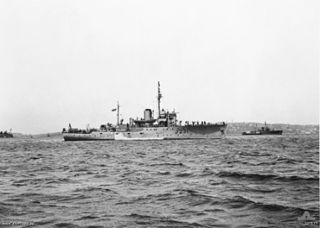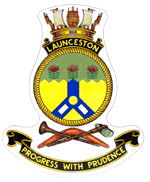
HMAS Benalla (J323/M323), named for the city of Benalla, Victoria, was one of 60 Bathurst-class corvettes constructed during World War II, and one of 36 initially manned and commissioned solely by the Royal Australian Navy (RAN). Built by HMA Naval Dockyard in Victoria, Benalla was fitted out as armed survey ship instead of a minesweeper like the rest of the class, and was commissioned into the RAN in 1943.

HMAS Bowen (J285/M285), named for the town of Bowen, Queensland, was a Bathurst-class corvette of the Royal Australian Navy.

HMAS Broome (J191), named for the town of Broome, Western Australia, was one of 60 Bathurst-class corvettes constructed during World War II and one of 20 built for the Admiralty but manned by personnel of and commissioned into the Royal Australian Navy (RAN).

HMAS Deloraine (J232/M232), named for the town of Deloraine, Tasmania, was one of 60 Bathurst-class corvettes constructed during World War II, and one of 36 initially manned and commissioned solely by the Royal Australian Navy (RAN). In January 1942 she evaded an attack by the Japanese submarine I-124 north-west of Darwin and was jointly credited with the submarine's sinking after inflicting the initial damage. She was present at the bombing of Darwin and survived unscathed.

HMAS Echuca (J252/M252), named for the town of Echuca, Victoria, was one of 60 Bathurst-class corvettes constructed during World War II, and one of 36 initially manned and commissioned by the Royal Australian Navy (RAN).

HMAS Glenelg (J236/M236), named for the city of Glenelg, South Australia, was one of 60 Bathurst-class corvette constructed during World War II, and one of 36 initially manned and commissioned solely by the Royal Australian Navy (RAN).

HMAS Gympie (J238/M238), named for the city of Gympie, Queensland, was one of 60 Bathurst-class corvettes constructed during World War II, and one of 36 initially manned and commissioned solely by the Royal Australian Navy (RAN).

HMAS Kapunda (J218/M218), named for the town of Kapunda, South Australia, was one of 60 Bathurst-class corvettes constructed during World War II, and one of 36 initially manned and commissioned solely by the Royal Australian Navy (RAN).

HMAS Katoomba (J204/M204), named after the tourist resort of Katoomba, New South Wales, was one of 60 Bathurst-class corvettes constructed during World War II, and one of 36 initially crewed and commissioned solely by the Royal Australian Navy (RAN).

HMAS Latrobe (J234/M234), named for the town of Latrobe, Tasmania, was one of 60 Bathurst-class corvettes constructed during World War II, and one of 36 initially manned and commissioned solely by the Royal Australian Navy (RAN).

HMAS Lithgow (J206/M206), named for the city of Lithgow, New South Wales, Australia was one of 60 Bathurst-class corvettes constructed during World War II, and one of 36 initially manned and commissioned solely by the Royal Australian Navy (RAN).

HMAS Stawell (J348/M348) was a Bathurst-class corvette named for the town of Stawell, Victoria. Sixty Bathurst-class corvettes were constructed during World War II, and Stawell was one of 36 initially manned and commissioned solely by the Royal Australian Navy (RAN).

HMAS Cairns (J183), named for the city of Cairns, Queensland, was one of 60 Bathurst-class corvettes constructed during World War II and one of 20 built for the Admiralty but manned by personnel of and commissioned into the Royal Australian Navy (RAN).

HMAS Wallaroo (J222), named after the town of Wallaroo, South Australia, was one of 60 Bathurst-class corvettes constructed during World War II, and one of 36 initially manned and commissioned solely by the Royal Australian Navy (RAN). Wallaroo was one of only three Bathursts lost during World War II; following a collision with US Liberty ship Henry Gilbert Costin on the night of 11 June 1943.

HMAS Parkes (J361), named for the town of Parkes, New South Wales, was one of 60 Bathurst-class corvettes constructed in Australia during World War II, and one of 36 initially manned and commissioned by the Royal Australian Navy (RAN).

HMAS Bunbury (J241/M241), named for the city of Bunbury, Western Australia, was one of 60 Bathurst-class corvettes constructed during World War II, and one of 36 initially manned and commissioned solely by the Royal Australian Navy (RAN).

HMAS Bundaberg (J231/M231), named for the city of Bundaberg, Queensland, was one of 60 Bathurst-class corvettes constructed during World War II, and one of 36 initially manned and commissioned solely by the Royal Australian Navy (RAN).

HMAS Fremantle (J246/M246), named for the port city of Fremantle, Western Australia, was one of 60 Bathurst-class corvettes constructed during World War II, and one of 36 initially manned and commissioned solely by the Royal Australian Navy (RAN).

HMAS Geraldton (J178/B242/A116), named for the city of Geraldton, Western Australia, was one of 60 Bathurst-class corvettes constructed during World War II and one of 20 built for the Admiralty but manned by personnel of and commissioned into the Royal Australian Navy (RAN).

HMAS Launceston (J179/B246/A120), named for the city of Launceston, Tasmania, was one of 60 Bathurst-class corvettes constructed during World War II and one of 20 built for the Admiralty but manned by personnel of and commissioned into the Royal Australian Navy (RAN).




















